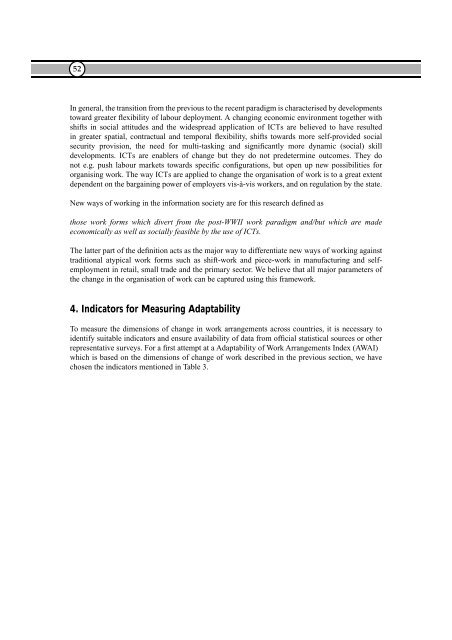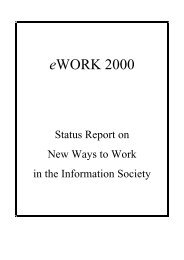Proceedings of 8th European Assembly on telework (Telework2001)
Proceedings of 8th European Assembly on telework (Telework2001)
Proceedings of 8th European Assembly on telework (Telework2001)
You also want an ePaper? Increase the reach of your titles
YUMPU automatically turns print PDFs into web optimized ePapers that Google loves.
52In general, the transiti<strong>on</strong> from the previous to the recent paradigm is characterised by developmentstoward greater flexibility <str<strong>on</strong>g>of</str<strong>on</strong>g> labour deployment. A changing ec<strong>on</strong>omic envir<strong>on</strong>ment together withshifts in social attitudes and the widespread applicati<strong>on</strong> <str<strong>on</strong>g>of</str<strong>on</strong>g> ICTs are believed to have resultedin greater spatial, c<strong>on</strong>tractual and temporal flexibility, shifts towards more self-provided socialsecurity provisi<strong>on</strong>, the need for multi-tasking and significantly more dynamic (social) skilldevelopments. ICTs are enablers <str<strong>on</strong>g>of</str<strong>on</strong>g> change but they do not predetermine outcomes. They d<strong>on</strong>ot e.g. push labour markets towards specific c<strong>on</strong>figurati<strong>on</strong>s, but open up new possibilities fororganising work. The way ICTs are applied to change the organisati<strong>on</strong> <str<strong>on</strong>g>of</str<strong>on</strong>g> work is to a great extentdependent <strong>on</strong> the bargaining power <str<strong>on</strong>g>of</str<strong>on</strong>g> employers vis-à-vis workers, and <strong>on</strong> regulati<strong>on</strong> by the state.New ways <str<strong>on</strong>g>of</str<strong>on</strong>g> working in the informati<strong>on</strong> society are for this research defined asthose work forms which divert from the post-WWII work paradigm and/but which are madeec<strong>on</strong>omically as well as socially feasible by the use <str<strong>on</strong>g>of</str<strong>on</strong>g> ICTs.The latter part <str<strong>on</strong>g>of</str<strong>on</strong>g> the definiti<strong>on</strong> acts as the major way to differentiate new ways <str<strong>on</strong>g>of</str<strong>on</strong>g> working againsttraditi<strong>on</strong>al atypical work forms such as shift-work and piece-work in manufacturing and selfemploymentin retail, small trade and the primary sector. We believe that all major parameters <str<strong>on</strong>g>of</str<strong>on</strong>g>the change in the organisati<strong>on</strong> <str<strong>on</strong>g>of</str<strong>on</strong>g> work can be captured using this framework.4. Indicators for Measuring AdaptabilityTo measure the dimensi<strong>on</strong>s <str<strong>on</strong>g>of</str<strong>on</strong>g> change in work arrangements across countries, it is necessary toidentify suitable indicators and ensure availability <str<strong>on</strong>g>of</str<strong>on</strong>g> data from <str<strong>on</strong>g>of</str<strong>on</strong>g>ficial statistical sources or otherrepresentative surveys. For a first attempt at a Adaptability <str<strong>on</strong>g>of</str<strong>on</strong>g> Work Arrangements Index (AWAI)which is based <strong>on</strong> the dimensi<strong>on</strong>s <str<strong>on</strong>g>of</str<strong>on</strong>g> change <str<strong>on</strong>g>of</str<strong>on</strong>g> work described in the previous secti<strong>on</strong>, we havechosen the indicators menti<strong>on</strong>ed in Table 3.








